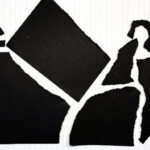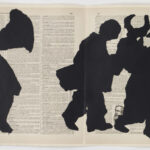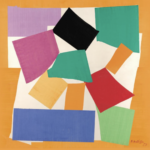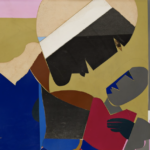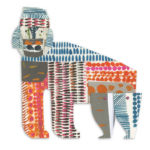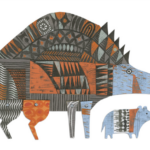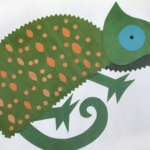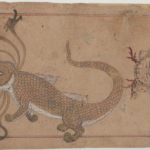Overview
In this unit, students will explore tearing, cutting, and arranging shapes, then make collages of realistic and imaginary animals, focusing on shape, detail, and pattern.
Lessons
Materials and Tools
- Sheets of different colored, patterned, and/or textured paper
- Glue or tape
- Scissors
Alternative Materials
For all collage lessons, teachers can challenge students to find interesting paper and collage materials at home. These may be wrapping paper, tissue paper, or anything found in the paper recycling bin.
Teachers can also order different papers:
- Decorative papers: https://www.dickblick.com/items/decorative-paper-assorted-1-lb/
- Construction papers: https://www.dickblick.com/products/blick-construction-paper/
- Tissue papers: https://www.dickblick.com/products/pacon-spectra-remnant-art-tissue-pack/
Students can draw organic and geometric shapes and animals with oil pastels:
- Crayola oil pastels: https://www.dickblick.com/products/crayola-oil-pastels/
Students can sculpt three-dimensional imaginary and real animals using Model Magic:
https://www.dickblick.com/items/crayola-model-magic-classpack-pack-of-75-1-oz-assorted/
Objectives
- Students will find and collect a variety of materials and experiment with attaching them together
- Students will transform and arrange materials to convey meaning and explore facial expressions
- Students will document their work to compare and contrast each experiment
Student Outcomes
Students will understand that:
- Selection is a powerful tool of expression that demonstrates preferences and identities
- By arranging and rearranging materials, multiple meanings can be explored
- Artists evoke emotion through their use of materials
Students will be able to:
- Gain sensitivity to materials and identify uses for them beyond their original functions
- Demonstrate how to change the meaning of objects within different contexts
- Apply knowledge about materials, attachment strategies, and transformation to create expressive faces using nontraditional materials
Resources
The Metropolitan Museum of Art
Images of Islamic geometric patterns in tile and fabric
The Getty Museum
Insect Anatomy and the Scientist as Illustrator: Studying and Drawing Insects
Adaptations
For Students with Disabilities
- Use motions, or your body, to make lines, shapes, and patterns
- Feel cut and torn shapes and describe them
- Think about the sounds a line might make, or that you might hear in an artwork
- Use sounds to make repeating patterns
- Make patterns with manipulatives
- Think about and incorporate the sounds or movements that animals make
- Use technology to draw shapes instead of cutting (iPad, Google Classroom, Smartboard)
- Use audio with visuals in student-facing lesson guides
- Speak into a recording device or have a teacher write the child’s words
- Turn and talk to a partner before writing
For Multilingual Learners
- Students can point to specific parts of their collage as an answer to a prompt or question
- Students can label a picture of their work digitally by dragging words onto parts of their collage and saving. They can use labels that describe edges (smooth, rough) and shapes (triangle, circle)
- Students can use prompts to write a full sentence and/or choose from pre-written statements to answer questions
- Teachers can emphasize repetition of new art vocabulary and spiral vocabulary and activate students’ prior knowledge
- Teachers can use shapes paired with vocabulary words to help with meaning
- Teachers can use icons or symbols to provide a visual for shapes and patterns
- Teachers can use sentence starters and word banks
- Teachers and students can use Total Physical Response (TPR) to draw shapes in the air with their fingers or hands
- Teachers can use signposts—telling students what they are going to do next
- Teachers can chunk information and keep instructions concise
- Teachers can elicit information by asking questions, giving students time to think about an answer, and extending wait time
- Teachers can use multiple entry points: speaking, showing, and doing
- Teachers can use audio with visuals in student-facing lesson guides
Extensions
Connecting to Math Curriculum
- Exploring symmetry, students can make symmetrical collages, using precut shapes or cutting shapes themselves
- Students can look at their collage and make a mirror image drawing of it
- Students can be challenged to make their cut-out shapes three-dimensional by folding, bending, or curling the paper. The shapes can be glued or taped to make free-standing sculptures. These can be measured, or shapes can be counted or multiplied to connect to a math curriculum
- After tearing and cutting shapes to make collages, students can make additional artwork related to counting shapes. For example, they can count their shapes and make a drawing with: twice the amount of shapes; half the amount of shapes; or with six shapes added
Connecting to Science Curriculum
- Students can draw, collage, or build a habitat for the animal they made. They can create a diorama using recycled materials, paper packaging, or found natural objects and explain in a writing assignment what the habitat consists of and why or what the animal does in it. For ideas: https://www.firstpalette.com/craft/rainforest-diorama.html
Connecting to ELA Curriculum
- Students can write stories about their animal or describe their character. They can also make artwork about their imagined friends or family
Connecting to Social Studies Curriculum
- Students can draw, collage, or build a habitat for their imaginary animal and explain whether it’s an urban or rural setting and what modes of transportation it has, if any
- Students can make a collage of a symbol, after practicing cutting shapes. The symbol can be for: their school, their family, the place where they like to play, etc.
New York Teaching & Learning in Visual Arts Standards
Art Making: 2nd Grade Learning Indicators for Drawing and Collage
Create a collage that demonstrates:
- Manipulation of cut shapes to represent a real or imaginary subject
- Experimentation with cutting organic and geometric shapes in a variety of sizes
- Experimentation with tearing paper
- Exploration and expressive use of colored paper to represent a subject
- Imaginative placement of shapes
- Basic understanding of overlapping
Literacy in the Arts
- Looking At and Discussing Art
- Developing Visual Arts Vocabulary
- Reading and Writing About Art
- Problem Solving: Interpreting and Analyzing Art
Making Connections
- Recognizing the Societal, Cultural, and Historical Significance of Art; Connecting Art to Other Disciplines
- Observing and Interpreting the World
Community and Cultural Resources
- Cultural Institutions
- Online Resources and Libraries
Careers and Lifelong Learning
- Art for Enjoyment and Lifelong Learning
NYS Learning Standards for the Arts
Artistic Process: Creating
Anchor Standards:
- Anchor Standard 1: Generate and conceptualize artistic ideas and work
- Anchor Standard 2: Organize and develop artistic ideas and work
- Anchor Standard 3: Refine and complete artistic work
Artistic Process: Presenting
Anchor Standards:
- Anchor Standard 4: Select, analyze, and interpret artistic work for presentation
- Anchor Standard 5: Develop and refine artistic techniques and work for presentation
- Anchor Standard 6: Convey meaning through the presentation of artistic work
Artistic Process: Responding
Anchor Standards:
- Anchor Standard 7: Perceive and analyze artistic work
- Anchor Standard 8: Interpret meaning in artistic work
- Anchor Standard 9: Apply criteria to evaluate artistic work
Artistic Process: Connecting
Anchor Standards:
- Anchor Standard 10: Relate and synthesize knowledge and personal experiences to inspire and inform artistic work
- Anchor Standard 11: Investigate ways that artistic work is influenced by societal, cultural, and historical context and, in turn, how artistic ideas shape cultures past, present, and future
Credits
Writing Team
Andrea Burgay, Traci Talasco, Jill Slaymaker, Monika Zarzeczna
Project Team
Belinda Blum, Nicola Giardina, Paul Urevitch, Andrea Burgay
Studio in a School NYC Team
Julie Applebaum, Senior Director
Hasna Muhammad, Ed.D., Chair, Board of Directors, Studio in a School Association
Alison Scott-Williams, President, Studio in a School NYC
NYC Department of Education OASP Team
Karen Rosner, Director of Visual Arts
Amber Lodman, Arts Program Manager
Kaitlin Trammell, Remote Arts Learning Partnership Project Coordinator
NYC Department of Education Visual Arts Teacher Team
Maria Bonilla, Amie Robinson, Susan Bricker, Lara Tyson
These educational materials were created through a partnership with Studio in a School NYC and The New York City Department of Education Office of Arts and Special Projects (OASP) and made possible by the generosity of The New York Community Trust.
Copyright © 2023 Studio in a School NYC LLC


